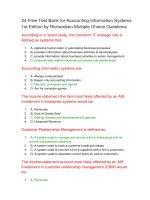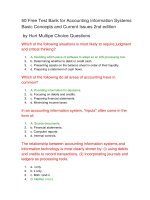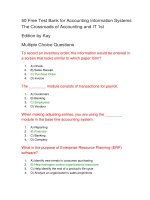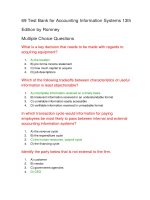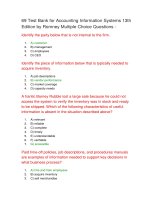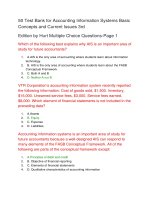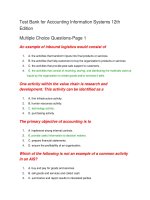91 test bank for intermediate accounting 13th edition kieso
Bạn đang xem bản rút gọn của tài liệu. Xem và tải ngay bản đầy đủ của tài liệu tại đây (104.42 KB, 25 trang )
91 Test Bank for Intermediate Accounting 13th Edition
Kieso
True-False Questions
Financial Accounting Concepts set forth fundamental objectives and
concepts that are used in developing future standards of financial accounting
and reporting.
1.
True
2.
False
Ethical issues in financial accounting are governed by the AICPA.
1.
True
2.
False
The standard-setting structure used by the International Accounting
Standards Board is very similar to that used by the Financial Accounting
Standards Board.
1.
True
2.
False
The passage of a new FASB Standards Statement requires the support of five
of the seven board members.
1.
True
2.
False
Accounting standards are now less likely to require the recording or
disclosure of fair value information due to its inherent subjectivity.
1.
True
2.
False
Accounting standards are a product of careful logic or empirical findings and
are not influenced by political action.
1.
True
2.
False
The International Accounting Standards Board issues International Financial
Reporting Standards.
1.
True
2.
False
The AICPA’s Code of Professional Conduct requires that members prepare
financial statements in accordance with generally accepted accounting
principles.
1.
True
2.
False
The Securities and Exchange Commission appointed the Committee on
Accounting Procedure.
1.
True
2.
False
Currently, both U.S. GAAP and the International Financial Reporting
Standards are acceptable for international use.
1.
True
2.
False
The expectations gap is caused by what the public thinks accountants should
be doing and what accountants think they can do.
1.
True
2.
False
International Accounting Standards are no longer considered part of iGAAP
because they have been replaced by International Financial Reporting
Standards.
1.
True
2.
False
The AICPA created the Accounting Principles Board in 1959.
1.
True
2.
False
International Financial Reporting Standards preceded International
Accounting Standards.
1.
True
2.
False
An effective process of capital allocation promotes productivity and provides
an efficient market for buying and selling securities and obtaining and
granting credit.
1.
True
2.
False
Financial statements are the principal means through which financial
information is communicated to those outside an enterprise.
1.
True
2.
False
Some generally accepted accounting principles have simply been accepted as
appropriate because of their universal application rather than due to the
action of an authoritative accounting rule-making body.
1.
True
2.
False
The rules-based standards of iGAAP are more detailed than the simpler,
principles-based standards of U.S. GAAP.
1.
True
2.
False
Users of the financial information provided by a company use that information
to make capital allocation decisions.
1.
True
2.
False
Financial reports in the early 21st century did not provide any information
about a company’s soft assets.
1.
True
2.
False
FASB Technical Bulletins are more authoritative than FASB Standards and
Interpretations.
1.
True
2.
False
One weakness of accrual accounting is that it does not provide a good
indication of the enterprise's present and continuing ability to generate
favorable cash flows.
1.
True
2.
False
Users of financial accounting statements have both coinciding and conflicting
needs for information of various types.
1.
True
2.
False
While objectives for financial reporting exist on an informal basis, no formal
objectives have been adopted.
1.
True
2.
False
Financial accounting is the process of identifying, measuring, analyzing, and
communicating financial information needed by management to plan,
evaluate, and control an organiza-tion's operations.
1.
True
2.
False
iGAAP includes both International Financial Reporting Standards and
International Accounting Standards.
1.
True
2.
False
Multiple Choice Questions-Page 1
General-purpose financial statements are the product of
1.
a.financial accounting.
2.
b.managerial accounting.
3.
c.both financial and managerial accounting.
4.
d.neither financial nor managerial accounting.
Whether a business is successful and thrives is determined by
1.
a.markets.
2.
b.free enterprise.
3.
c.competition.
4.
d.all of these.
What is a major objective of financial reporting?
1.
a.Provide information that is useful to the Internal Revenue Service in determining the
amount of federal income taxes payable.
2.
b.Provide information that is useful in assessing the amounts and timing of revenue.
3.
c.Provide information that is comprehensible only by sophisticated investors.
4.
d.Provide information that clearly portrays the economic resources of an enterprise.
Financial statements in the early 2000s provide information related to
1.
a.nonfinancial measurements.
2.
b.forward-looking data.
3.
c.hard assets (inventory and plant assets).
4.
d.none of these.
Which organization was responsible for issuing Accounting Research
Bulletins?
1.
a.Accounting Principles Board.
2.
b.Committee on Accounting Procedure.
3.
c.The SEC.
4.
d.AICPA.
A common set of accounting standards and procedures are called
1.
a.financial accounting standards.
2.
b.generally accepted accounting principles.
3.
c.objectives of financial reporting.
4.
d.statements of financial accounting concepts.
Which of the following statements is not an objective of financial reporting?
1.
a.Provide information that is useful in investment and credit decisions.
2.
b.Provide information about enterprise resources, claims to those resources, and
changes to them.
3.
c.Provide information on the liquidation value of an enterprise.
4.
d.Provide information that is useful in assessing cash flow prospects.
Which of the following is not a major challenge facing the accounting
profession?
1.
a.Nonfinancial measurements.
2.
b.Timeliness.
3.
c.Accounting for hard assets.
4.
d.Forward-looking information.
Which of the following organizations has been responsible for setting U.S.
accounting standards?
1.
a.Accounting Principles Board.
2.
b.Committee on Accounting Procedure.
3.
c.Financial Accounting Standards Board.
4.
d.All of the above.
Which organization is responsible for issuing Emerging Issues Task Force
Statements?
1.
a.FASB
2.
b.CAP
3.
c.APB
4.
d.SEC
The information provided by financial reporting pertains to
1.
a.individual business enterprises, rather than to industries or an economy as a whole
or to members of society as consumers.
2.
b.business industries, rather than to individual enterprises or an economy as a whole
or to members of society as consumers.
3.
c.individual business enterprises, industries, and an economy as a whole, rather than
to members of society as consumers.
4.
d.an economy as a whole and to members of society as consumers, rather than to
individual enterprises or industries.
What is the relationship between the Securities and Exchange Commission
and accounting standard setting in the United States?
1.
a.The SEC requires all companies listed on an exchange to submit their financial
statements to the SEC.
2.
b.The SEC coordinates with the AICPA in establishing accounting standards.
3.
c.The SEC has a mandate to establish accounting standards for enterprises under its
jurisdiction.
4.
d.The SEC reviews financial statements for compliance.
Accounting principles are "generally accepted" only when
1.
a.an authoritative accounting rule-making body has established it in an official pronouncement.
2.
b.it has been accepted as appropriate because of its universal application.
3.
c.both a and b.
4.
d.neither a nor b.
The financial statements most frequently provided include all of the following
except the
1.
a.balance sheet.
2.
b.income statement.
3.
c.statement of cash flows.
4.
d.statement of retained earnings.
Characteristics of generally accepted accounting principles include all of the
following except
1.
a.authoritative accounting the rule-making body established a principle of reporting.
2.
b.standards are considered useful by the profession.
3.
c.each principle is approved by the SEC.
4.
d.practice has become universally accepted over time.
Why was it believed that accounting standards that were issued by the
Financial Accounting Standards Board would carry more weight?
1.
a.Smaller membership.
2.
b.FASB board members are well-paid.
3.
c.FASB board members must be CPAs.
4.
d.Due process.
An effective capital allocation process
1.
a.promotes productivity.
2.
b.encourages innovation.
3.
c.provides an efficient market for buying and selling securities.
4.
d.all of these.
What is due process in the context of standard setting at the FASB?
1.
a.FASB operates in full view of the public.
2.
b.Public hearings are held on proposed accounting standards.
3.
c.Interested parties can make their views known.
4.
d.All of the above.
Which of the following represents a form of communication through financial
reporting but not through financial statements?
1.
a.Balance sheet.
2.
b.President's letter.
3.
c.Income statement.
4.
d.Notes to financial statements.
All the following are differences between financial and managerial accounting
in how accounting information is used except to
1.
a.plan and control company's operations.
2.
b.decide whether to invest in the company.
3.
c.evaluate borrowing capacity to determine the extent of a loan to grant.
4.
d.All the above.
The role of the Securities and Exchange Commission in the formulation of
accounting principles can be best described as
1.
a.consistently primary.
2.
b.consistently secondary.
3.
c.sometimes primary and sometimes secondary.
4.
d.non-existent.
A characteristic of generally accepted accounting principles include the
following
1.
a.common set of standards and principles.
2.
b.standards and principles are based federal statutes.
3.
c.acceptance requires an affirmative vote of Certified Public Accountants.
4.
d.practices that become accepted for at least a year by all industry members.
Accrual accounting is used because
1.
a.cash flows are considered less important.
2.
b.it provides a better indication of ability to generate cash flows than the cash basis.
3.
c.it recognizes revenues when cash is received and expenses when cash is paid.
4.
d. none of the above.
What is a major objective of financial reporting?
1.
a.Provide information that is useful to management in making decisions.
2.
b.Provide information that clearly portray nonfinancial transactions.
3.
c.Provide information that is useful to assess the amounts, timing, and uncertainty of
perspective cash receipts.
4.
d.Provide information that excludes claims to the resources.
Which of the following is a general limitation of "general purpose financial
statements"?
1.
a.General purpose financial statements may not be the most informative for a specific
enterprise.
2.
b.General purpose financial statements are comparable.
3.
c.General purpose financial statements are assumed to present fairly the company's
financial operations.
4.
d.None of the above.
The passage of a new FASB Standards Statement requires the support of
1.
a.all Board members.
2.
b.three Board members.
3.
c.four Board members.
4.
d.five Board members.
Users of financial reports include all of the following except
1.
a.creditors.
2.
b.government agencies.
3.
c.unions.
4.
d.All of these are users.
One objective of financial reporting is to provide
1.
a.information about the investors in the business entity.
2.
b.information about the liquidation values of the resources held by the enterprise.
3.
c.information that is useful in assessing cash flow prospects.
4.
d.information that will attract new investors.
How does accounting help the capital allocation process attract investment
capital?
1.
a.Provides timely, relevant information.
2.
b.Encourages innovation.
3.
c.Promotes productivity.
4.
d.a and b above.
What is the purpose of Emerging Issues Task Force?
1.
a.Provide interpretation of existing standards.
2.
b.Provide a consensus on how to account for new and unusual financial transactions.
3.
c.Provide interpretive guidance.
4.
d.Provide timely guidance on select issues.
Why did the AICPA create the Accounting Principles Board?
1.
a.The SEC disbanded the previous standard setting organization.
2.
b.The previous standard setting organization did not provide a structured set of
accounting principles.
3.
c.No such organization existed in the past.
4.
d.None of the above.
65 Free Test Bank for Intermediate Accounting 13th
Edition Kieso Multiple Choice Questions-Page 2
The purpose of the Emerging Issues Task Force is to
1.
a.develop a conceptual framework as a frame of reference for the solution of future
problems.
2.
b.lobby the FASB on issues that affect a particular industry.
3.
c.do research on issues that relate to long-term accounting problems.
4.
d.issue statements which reflect a consensus on how to account for new and unusual
financial transactions that need to be resolved quickly.
What is not a source of pressure that may influence the accounting standard
setting process?
1.
a.Congress.
2.
b.Lobbyist.
3.
c.CPA firms.
4.
d.None of the above.
Financial accounting standard-setting in the United States
1.
a.can be described as a social process which reflects political actions of various
interested user groups as well as a product of research and logic.
2.
b.is based solely on research and empirical findings.
3.
c.is a legalistic process based on rules promulgated by governmental agencies.
4.
d.is democratic in the sense that a majority of accountants must agree with a standard
before it becomes enforceable.
Exposure Draft Q#SStatement of Financial Accounting Standards
Q#SPreliminary Views The chronological order in which these items are
released is as follows:
1.
a.1, 2, 3.
2.
b.1, 3, 2.
3.
c.2, 3, 1.
4.
d.3, 1, 2.
Which of these statements regarding the iGAAP and U.S. GAAP is correct?
1.
a.U.S. GAAP is considered to be "principles-based" and more detailed than iGAAP.
2.
b.U.S. GAAP is considered to be "rules-based" and less detailed than iGAAP.
3.
c.iGAAP is considered to be "principles-based" and less detailed than U.S. GAAP
4.
d.Both U.S. GAAP and iGAAP are considered to be "rules-based", but U.S. GAAP
tends to be more complex.
FASB Technical Bulletins
1.
a.are similar to FASB Interpretations in that they establish enforceable standards under
the AICPA's Code of Professional Ethics.
2.
b.are issued monthly by the FASB to deal with current topics.
3.
c.are not expected to have a significant impact on financial reporting in general and
provide guidance when it does not conflict with any broad fundamental accounting
principle.
4.
d.were recently discontinued by the FASB because they dealt with specialized topics
having little impact on financial reporting in general.
An organization that has not published accounting standards is the
1.
a.American Institute of Certified Public Accountants.
2.
b.Securities and Exchange Commission.
3.
c.Financial Accounting Standards Board.
4.
d.All of these have published accounting standards.
Rule 203 of the Code of Professional Conduct address:
1.
a.ethical requirements.
2.
b.financial statements should be based on generally accepted accounting principles.
3.
c.advertising to obtained clients.
4.
d.auditing financial statements.
The IASB's standard-setting structure includes all of the following except
1.
a.Standing Interpretations Committee
2.
b.Standards Advisory Council
3.
c.Standards Comparison Committee.
The Financial Accounting Standards Board employs a "due process" system
which
1.
a.is an efficient system for collecting dues from members.
2.
b.enables interested parties to express their views on issues under consideration.
3.
c.identifies the accounting issues that are the most important.
4.
d.requires that all accountants must receive a copy of financial standards.
Which of the following organizations has not been instrumental in the
development of financial accounting standards in the United States?
1.
a.AICPA
2.
b.FASB
3.
c.IASB
4.
d.SEC.
Which of the following is not a part of generally accepted accounting
principles?
1.
a.FASB Interpretations
2.
b.CAP Accounting Research Bulletins
3.
c.APB Opinions
4.
d.All of these are part of generally accepted accounting principles.
What would be an advantage of having all countries adopt and follow the
same accounting standards?
1.
a.Consistency.
2.
b.Comparability.
3.
c.Lower preparation costs.
4.
d.b and c.
Which of the following is not considered a component of generally accepted
accounting principles?
1.
a.FASB Implementation Guides.
2.
b.Widely recognized industry practices.
3.
c.Articles published in CPA journals.
4.
d.AICPA Accounting Interpretations.
Which of the following publications does not qualify as a statement of
generally accepted accounting principles?
1.
a.Statements of financial standards issued by the FASB
2.
b.Accounting interpretations issued by the FASB
3.
c.APB Opinions
4.
d.Accounting research studies issued by the AICPA.
The purpose of the International Accounting Standards Board is to
1.
a.issue enforceable standards which regulate the financial accounting and reporting of
multinational corporations.
2.
b.develop a uniform currency in which the financial transactions of companies throughout the world would be measured.
3.
c.promote uniform accounting standards among countries of the world.
4.
d.arbitrate accounting disputes between auditors and international companies.
What is "expectation gap"?
1.
a.The difference between what the public thinks the accountant is not doing and what
the accountant knows they don't do.
2.
b.The difference between what the public thinks the accountant is doing and what
Congress says the accountant is doing.
3.
c.The difference between what the public thinks the accountant is doing and what the
accountant thinks they can do.
4.
d.The difference between what the accountant is doing and what the Courts say the
accountant should be doing.
The American Institute of Certified Public Accountants (AICPA) continues to
be involved in all of the following except
1.
a.developing and enforcing professional ethics.
2.
b.developing auditing standards.
3.
c.providing professional education programs.
4.
d.all of the above.
The major distinction between the Financial Accounting Standards Board
(FASB) and its predecessor, the Accounting Principles Board (APB), is
1.
a.the FASB issues exposure drafts of proposed standards.
2.
b.all members of the FASB are fully remunerated, serve full time, and are independent
of any companies or institutions.
3.
c.all members of the FASB possess extensive experience in financial reporting.
4.
d.a majority of the members of the FASB are CPAs drawn from public practice.
What is the purpose of a FASB Staff Position?
1.
a.Provide interpretation of existing standards.
2.
b.Provide a consensus on how to account for new and unusual financial transactions.
3.
c.Provide interpretive guidance.
4.
d.Provide timely guidance on select issues.
Which of the following is not a publication of the FASB?
1.
a.Statements of Financial Accounting Concepts
2.
b.Accounting Research Bulletins
3.
c.Interpretations
4.
d.Technical Bulletins.
What is not a reason that accounting standards may differ across countries?
1.
a.Governments.
2.
b.Language.
3.
c.Culture.
4.
d.Past Practice.
What is a possible danger if politics plays too big a role in accounting
standard setting?
1.
a.Accounting standards that are not truly generally accepted.
2.
b.Individuals may influence the standards.
3.
c.User groups become active.
4.
d.The FASB delegates its authority to elected officials.
The most significant current source of generally accepted accounting
principles is the
1.
a.AICPA.
2.
b.SEC.
3.
c.APB.
4.
d.FASB.
Which of the following pronouncements were issued by the Accounting
Principles Board?
1.
a.Accounting Research Bulletins
2.
b. Opinions
3.
c. Statements of Position
4.
d. Statements of Financial Accounting Concepts.
Authoritative standards for iGAAP include:
1.
a.International Financial Reporting Standards only.
2.
b.International Financial Reporting Standards and International Accounting Standards
only.
3.
c.International Financial Reporting Standards, International Accounting Standards and
U.S. GAAP only.
4.
d.International Financial Reporting Standards, International Accounting Standards and
any GAAP standard recognized by an organized stock exchange.
Generally accepted accounting principles
1.
a.include detailed practices and procedures as well as broad guidelines of general
application.
2.
b.are influenced by pronouncements of the SEC and IRS.
3.
c.change over time as the nature of the business environment changes.
4.
d.all of these.
The body that has the power to prescribe the accounting practices and
standards to be employed by companies that fall under its jurisdiction is the
1.
a.FASB.
2.
b.AICPA.
3.
c.SEC.
4.
d.APB.
The Financial Accounting Foundation
1.
a.oversees the operations of the FASB.
2.
b.oversees the operations of the AICPA.
3.
c.provides information to interested parties on financial reporting issues.
4.
d.works with the Financial Accounting Standards Advisory Council to provide information to interested parties on financial reporting issues.
Companies that are listed on a stock exchange are required to submit their
financial statements to the
1.
a.AICPA.
2.
b.APB
3.
c.FASB.
4.
d.SEC.
The Financial Accounting Standards Board (FASB) was proposed by the
1.
a.American Institute of Certified Public Accountants.
2.
b.Accounting Principles Board.
3.
c.Study Group on the Objectives of Financial Statements.
4.
d.Special Study Group on establishment of Accounting Principles (Wheat Committee).
The Financial Accounting Standards Board
1.
a.has issued a series of pronouncements entitled Statements on Auditing Standards.
2.
b.was the forerunner of the current Accounting Principles Board.
3.
c.is the arm of the Securities and Exchange Commission responsible for setting
financial accounting standards.
4.
d.is appointed by the Financial Accounting Foundation.
The purpose of Statements of Financial Accounting Concepts is to
1.
a.establish GAAP.
2.
b.modify or extend the existing FASB Standards Statement.
3.
c.form a conceptual framework for solving existing and emerging problems.
4.
d.determine the need for FASB involvement in an emerging issue.
Which of the following is an ethical concern of accountants?
1.
a.Earnings manipulation.
2.
b.Conservative accounting.
3.
c.Industry practices.
4.
d.None of the above.
